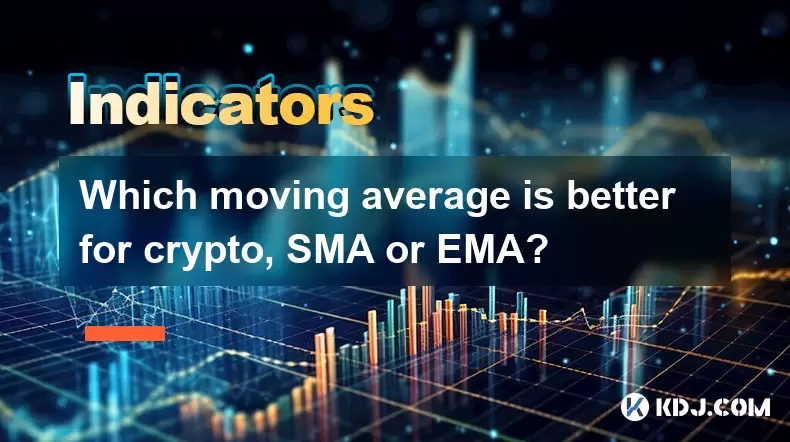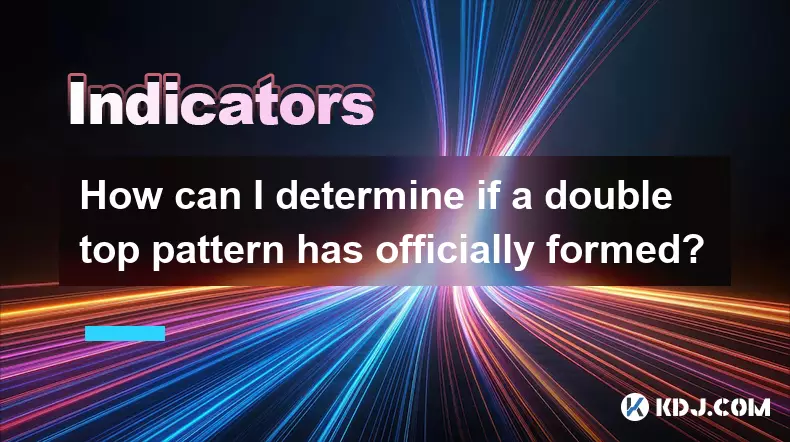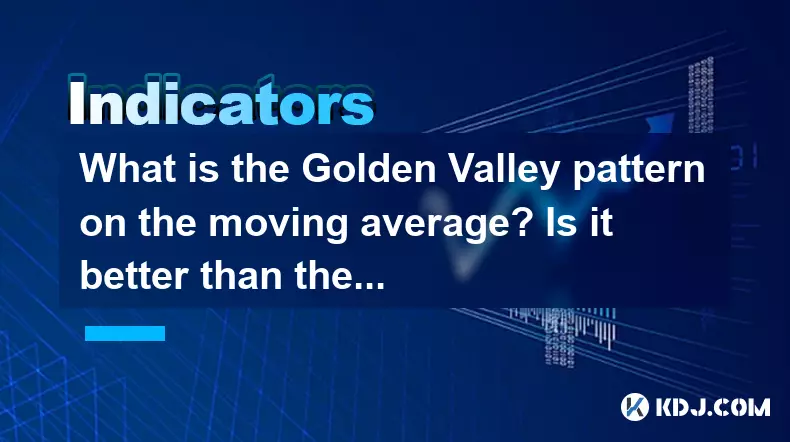-
 bitcoin
bitcoin $114320.977035 USD
-0.40% -
 ethereum
ethereum $4152.439985 USD
-1.75% -
 tether
tether $1.000111 USD
-0.04% -
 xrp
xrp $2.843037 USD
-1.63% -
 bnb
bnb $1013.349380 USD
-1.62% -
 solana
solana $208.362767 USD
-2.10% -
 usd-coin
usd-coin $0.999783 USD
0.00% -
 dogecoin
dogecoin $0.232559 USD
-1.00% -
 tron
tron $0.333491 USD
-1.09% -
 cardano
cardano $0.806310 USD
0.19% -
 hyperliquid
hyperliquid $45.023720 USD
-1.59% -
 ethena-usde
ethena-usde $1.000819 USD
-0.06% -
 chainlink
chainlink $21.241249 USD
-2.11% -
 avalanche
avalanche $30.035416 USD
-0.66% -
 stellar
stellar $0.364984 USD
-2.05%
Which moving average is better for crypto, SMA or EMA?
Moving averages like SMA and EMA help crypto traders identify trends, with EMA reacting faster to price changes and SMA offering smoother, long-term signals.
Aug 09, 2025 at 06:14 pm

Understanding Moving Averages in Cryptocurrency Trading
Moving averages are foundational tools in technical analysis, widely used by traders to identify trends and potential reversal points in cryptocurrency markets. Two of the most commonly used types are the Simple Moving Average (SMA) and the Exponential Moving Average (EMA). Both calculate the average price of an asset over a specified period but differ in how they weight the data. The SMA treats all prices equally, while the EMA assigns greater weight to recent prices, making it more responsive to new information. In the highly volatile crypto market, this distinction can significantly influence trading decisions.
How SMA Works and Its Role in Crypto Analysis
The Simple Moving Average is calculated by summing the closing prices of a cryptocurrency over a set number of periods and dividing by that number. For example, a 10-day SMA adds up the closing prices for the last 10 days and divides by 10. This method smooths out price data to form a line that helps identify the direction of the trend. Because it equally weights all data points, the SMA is slower to react to sudden price changes. This lag can be beneficial in filtering out market noise, especially in sideways or consolidating markets.
- Select a time frame, such as 20, 50, or 200 periods.
- Add the closing prices for those periods.
- Divide the total by the number of periods.
- Plot the result on the chart as a continuous line.
Traders often use SMAs to identify long-term support and resistance levels. The 200-day SMA, for instance, is a popular benchmark for determining the overall market trend in Bitcoin and other major cryptocurrencies. When the price is above this line, the trend is generally considered bullish.
How EMA Responds to Price Changes in Crypto Markets
The Exponential Moving Average places more emphasis on recent prices, making it more sensitive to new market developments. This responsiveness is achieved through a weighting multiplier that increases the impact of the latest data. As a result, EMAs react faster to price movements than SMAs, which can be a significant advantage in fast-moving crypto markets where prices can shift dramatically within hours.
- Choose a period (e.g., 12 or 26 days).
- Calculate the SMA for the first value.
- Apply the smoothing factor: ( \text{Multiplier} = \frac{2}{\text{Time Period} + 1} ).
- Use the formula: ( \text{EMA} = (\text{Price}\text{today} \times \text{Multiplier}) + (\text{EMA}\text{yesterday} \times (1 - \text{Multiplier})) ).
- Repeat the calculation for each new period.
Because of its speed, the EMA is frequently used in short-term trading strategies, such as scalping or day trading. It helps traders spot trend reversals earlier than the SMA, potentially offering better entry and exit points.
Comparing SMA and EMA in Volatile Crypto Conditions
Cryptocurrency markets are known for their high volatility, with prices often experiencing sharp rallies and sudden drops. In such environments, the choice between SMA and EMA becomes critical. The EMA’s sensitivity allows it to track price movements more closely, which can be advantageous when momentum shifts rapidly. However, this same sensitivity can lead to false signals during periods of choppy or sideways price action.
Conversely, the SMA’s slower response can act as a filter, reducing the number of misleading signals. While it may lag behind price changes, it provides a more stable view of the underlying trend. Traders who prioritize reliability over speed often prefer the SMA for swing or position trading. The key is aligning the moving average type with the trader’s time horizon and risk tolerance.
Practical Applications: Combining SMA and EMA for Better Signals
Many experienced crypto traders do not limit themselves to a single moving average. Instead, they use a combination of SMA and EMA to confirm trends and generate more reliable signals. One common strategy involves plotting both a short-term EMA (e.g., 12-period) and a long-term SMA (e.g., 50-period) on the same chart.
- When the EMA crosses above the SMA, it may indicate a bullish trend.
- When the EMA crosses below the SMA, it could signal a bearish shift.
- Use volume indicators to confirm the strength of the crossover.
- Adjust time frames based on the trading strategy—shorter for day trading, longer for investing.
Platforms like TradingView and Binance allow users to overlay multiple moving averages on price charts. Traders can customize colors and line styles to distinguish between SMA and EMA, making it easier to interpret crossovers and divergences.
Choosing the Right Moving Average for Your Strategy
The decision between SMA and EMA depends on the trader’s objectives. Those focused on long-term trend identification may find the SMA more suitable due to its stability. On the other hand, active traders seeking to capitalize on short-term momentum often benefit from the EMA’s responsiveness. There is no universal answer—each has strengths that align with different market conditions and trading styles.
Backtesting strategies using historical crypto price data can help determine which moving average performs better under specific scenarios. For example, testing a 50-day EMA versus a 50-day SMA on Bitcoin’s price action during a bull run can reveal which generates more accurate signals. Most trading platforms offer built-in backtesting tools or allow integration with Python libraries like Pandas and TA-Lib for deeper analysis.
Frequently Asked Questions
Can I use both SMA and EMA on the same chart?Yes, most charting platforms support multiple moving averages. Overlaying both allows you to compare their behavior and identify crossovers, which can serve as potential trade signals.
Which time frames work best for EMA in crypto trading?Shorter time frames like 9, 12, or 26 periods are commonly used for EMAs in day trading. The 12 and 26 EMAs are especially popular in the MACD indicator, widely used in crypto analysis.
Does the SMA work better in ranging markets?Yes, in sideways or consolidating markets, the SMA’s slower reaction helps avoid false breakouts. It provides a clearer baseline for support and resistance compared to the more jittery EMA.
Why does the EMA react faster than the SMA?The EMA applies a higher weighting to recent prices through a mathematical multiplier, allowing it to adjust more quickly to new data. The SMA treats all prices equally, resulting in a delayed response.
Disclaimer:info@kdj.com
The information provided is not trading advice. kdj.com does not assume any responsibility for any investments made based on the information provided in this article. Cryptocurrencies are highly volatile and it is highly recommended that you invest with caution after thorough research!
If you believe that the content used on this website infringes your copyright, please contact us immediately (info@kdj.com) and we will delete it promptly.
- BlockDAG, DOGE, HYPE Sponsorship: Crypto Trends Shaping 2025
- 2025-10-01 00:25:13
- Deutsche Börse and Circle: A StableCoin Adoption Powerhouse in Europe
- 2025-10-01 00:25:13
- BlockDAG's Presale Buzz: Is It the Crypto to Watch in October 2025?
- 2025-10-01 00:30:13
- Bitcoin, Crypto, and IQ: When Genius Meets Digital Gold?
- 2025-10-01 00:30:13
- Stablecoins, American Innovation, and Wallet Tokens: The Next Frontier
- 2025-10-01 00:35:12
- NBU, Coins, and Crypto in Ukraine: A New Yorker's Take
- 2025-10-01 00:45:14
Related knowledge

What is a tower bottom candlestick pattern? Does it have a high success rate?
Sep 22,2025 at 07:18am
Tower Bottom Candlestick Pattern Explained1. The tower bottom candlestick pattern is a reversal formation that typically appears at the end of a downt...

What is a black hole pattern in the MACD indicator? Is it a cause for concern?
Sep 21,2025 at 06:54pm
Bitcoin's Role in Decentralized Finance1. Bitcoin remains the cornerstone of decentralized finance, serving as a benchmark for value and security acro...

How can I use the psychological line (PSY) to determine market sentiment?
Sep 17,2025 at 02:19pm
Understanding the Psychological Line (PSY) in Cryptocurrency TradingThe Psychological Line, commonly referred to as PSY, is a momentum oscillator used...

How can I determine if a double top pattern has officially formed?
Sep 21,2025 at 03:18am
Understanding the Structure of a Double Top Pattern1. A double top pattern consists of two distinct peaks that reach approximately the same price leve...

What is the Golden Valley pattern on the moving average? Is it better than the Silver Valley pattern?
Sep 21,2025 at 02:54pm
Understanding the Golden Valley Pattern in Moving Averages1. The Golden Valley pattern is a technical formation observed in cryptocurrency price chart...

What does a death cross of the RSI in the strong zone (above 50) mean?
Sep 17,2025 at 10:54pm
Understanding the Death Cross in RSI Context1. The term 'death cross' is traditionally associated with moving averages, where a short-term average cro...

What is a tower bottom candlestick pattern? Does it have a high success rate?
Sep 22,2025 at 07:18am
Tower Bottom Candlestick Pattern Explained1. The tower bottom candlestick pattern is a reversal formation that typically appears at the end of a downt...

What is a black hole pattern in the MACD indicator? Is it a cause for concern?
Sep 21,2025 at 06:54pm
Bitcoin's Role in Decentralized Finance1. Bitcoin remains the cornerstone of decentralized finance, serving as a benchmark for value and security acro...

How can I use the psychological line (PSY) to determine market sentiment?
Sep 17,2025 at 02:19pm
Understanding the Psychological Line (PSY) in Cryptocurrency TradingThe Psychological Line, commonly referred to as PSY, is a momentum oscillator used...

How can I determine if a double top pattern has officially formed?
Sep 21,2025 at 03:18am
Understanding the Structure of a Double Top Pattern1. A double top pattern consists of two distinct peaks that reach approximately the same price leve...

What is the Golden Valley pattern on the moving average? Is it better than the Silver Valley pattern?
Sep 21,2025 at 02:54pm
Understanding the Golden Valley Pattern in Moving Averages1. The Golden Valley pattern is a technical formation observed in cryptocurrency price chart...

What does a death cross of the RSI in the strong zone (above 50) mean?
Sep 17,2025 at 10:54pm
Understanding the Death Cross in RSI Context1. The term 'death cross' is traditionally associated with moving averages, where a short-term average cro...
See all articles










































































